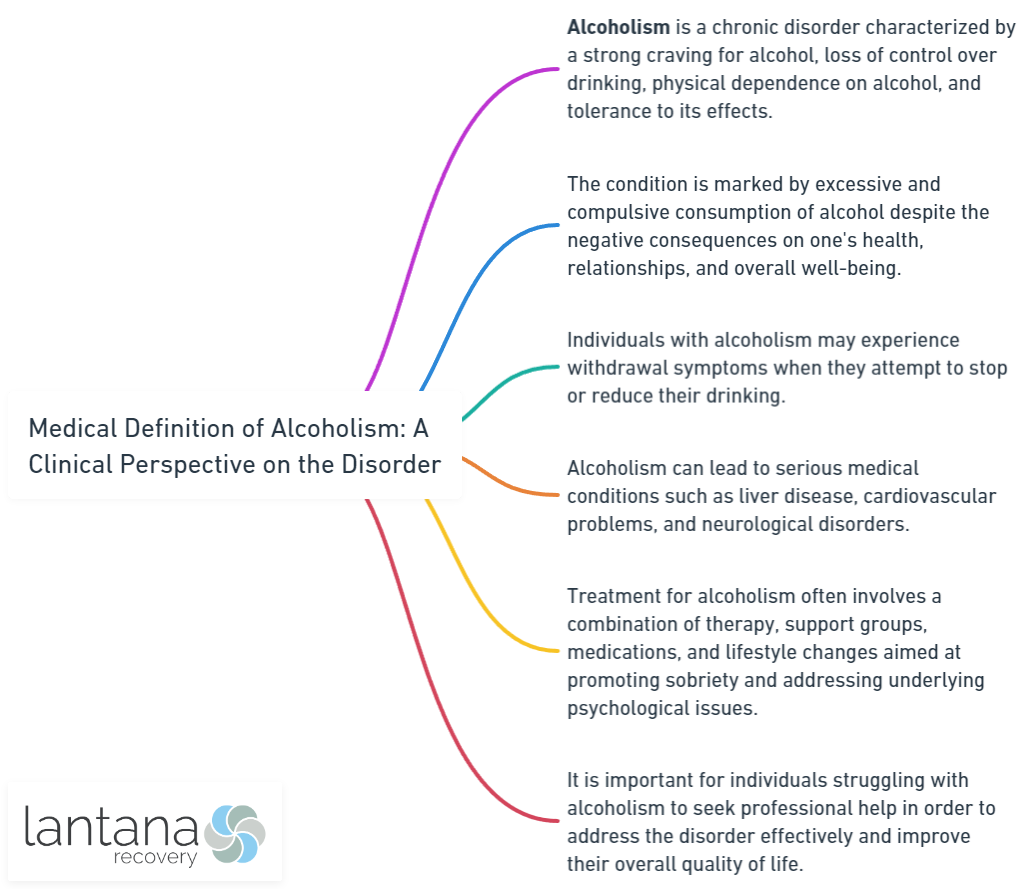Alcoholism, from a clinical perspective, is a complex and chronic disorder characterized by an excessive and compulsive consumption of alcohol, despite its negative consequences on an individual’s physical and mental health. In this article, we delve into the medical definition of alcoholism, its diagnosis, physiological effects, symptoms, causes, and the impact it has on relationships and society. We also explore the available treatment and recovery options, as well as prevention strategies to promote sobriety.
Understanding alcoholism begins with defining the condition and diagnosing it according to established criteria. We will explore the medical definition of alcoholism and the diagnostic criteria used to identify this disorder clinically. We’ll also examine the physiological effects of alcoholism on the body, including its impact on overall health and the specific effects on the brain. Alcoholism is known to have far-reaching consequences on both physical and mental well-being.
Recognizing the symptoms and signs of alcoholism is crucial for early intervention and effective treatment. We will explore the behavioral, physical, and psychological signs that may indicate the presence of alcoholism. To comprehend the underlying factors contributing to alcoholism, we will examine the causes and risk factors associated with this disorder. Genetic, environmental, and psychological factors all play a significant role in the development of alcoholism.
The impact of alcoholism extends beyond the individual to their relationships and society as a whole. We will explore the effects of alcoholism on family dynamics and its broader implications as a public health issue. Treatment and recovery options for alcoholism are critical in helping individuals regain control of their lives. Medical detoxification, behavioral therapies, and support groups such as 12-step programs are among the approaches utilized to address alcoholism effectively.
Finally, we will discuss prevention strategies that aim to reduce the incidence of alcoholism and promote sobriety. Early intervention, education, and efforts to reduce the stigma surrounding alcoholism all play a crucial role in prevention and supporting individuals on their journey to recovery.
By examining alcoholism from a clinical perspective, we aim to provide a comprehensive understanding of this disorder and offer insights into its diagnosis, effects, treatment, and prevention.
Understanding Alcoholism: Definition and Diagnosis
Alcoholism, or Alcohol Use Disorder (AUD), is a chronic brain disease. It is crucial to understand the definition and diagnosis of alcoholism in order to accurately recognize the signs and symptoms for appropriate treatment.
- Definition: Alcoholism, also known as Alcohol Use Disorder (AUD), is a compulsive urge to consume alcohol despite the negative consequences it has on physical health, mental well-being, and relationships. This disorder is influenced by both biological and environmental factors, leading to an inability to control or stop drinking.
- Diagnosis: Healthcare professionals rely on specific criteria outlined in the Diagnostic and Statistical Manual of Mental Disorders (DSM-5) to diagnose alcoholism. These criteria involve significant impairment or distress caused by alcohol use, as well as specific behavioral patterns such as loss of control, tolerance, and withdrawal symptoms.
Understanding alcoholism involves considering its impact on various aspects of an individual’s life. It can have detrimental effects on physical health, contributing to liver disease, cardiovascular problems, and psychiatric disorders. Additionally, alcoholism can strain relationships, interfere with personal and professional responsibilities, and increase the chances of accidents and legal issues.
Accurate diagnosis of alcoholism is crucial to develop personalized treatment plans. The primary objective of treatment is to assist individuals in achieving and maintaining sobriety while addressing any underlying mental health conditions. Treatment options may include behavioral therapies, support groups, medications, and holistic approaches that encompass the physical, emotional, and social aspects of recovery.
By comprehending the definition and diagnosis of alcoholism, individuals and healthcare professionals can collaborate to identify and manage this disorder, ultimately enhancing the lives of those affected.
What Is the Medical Definition of Alcoholism?
The medical definition of alcoholism is the inability to control or stop drinking, despite negative consequences. It is considered a substance use disorder and is diagnosed clinically based on specific criteria.
The Diagnostic and Statistical Manual of Mental Disorders (DSM-5) provides the official medical definition of alcoholism. According to the DSM-5, alcohol use disorder (AUD) is the preferred term used to describe alcoholism. It is a spectrum disorder that can range from mild to severe, depending on an individual’s symptoms.
To be diagnosed with AUD, an individual must meet certain criteria, including experiencing a problematic pattern of alcohol consumption that leads to distress or impairment in various areas of life. The DSM-5 criteria include factors such as craving for alcohol, unsuccessful efforts to cut down or control drinking, tolerance (needing more alcohol for desired effect), and withdrawal symptoms when alcohol use is stopped or reduced.
Clinicians may use screening tools or conduct interviews to diagnose alcoholism. These assessments evaluate an individual’s drinking patterns, behaviors, and physical and psychological symptoms associated with alcohol use. Obtaining an accurate diagnosis is crucial for providing appropriate treatment and support for individuals struggling with the three stages of alcoholism.
Understanding the medical definition of alcoholism is essential for identifying and addressing the disorder effectively. It provides a framework for healthcare professionals like those at Lantana to assess and diagnose individuals who may require intervention, treatment, or support to overcome their alcohol dependence.
What Are the Diagnostic Criteria for Alcoholism?
The diagnostic criteria for alcoholism, also known as alcohol addiction, are used by healthcare professionals to clinically diagnose individuals with this condition. These criteria help identify individuals who meet the specific criteria for alcoholism. When diagnosing alcoholism, healthcare professionals look for certain signs and symptoms that indicate a person’s alcohol use has become problematic. These diagnostic criteria are as follows:
1. Craving: This refers to a strong desire or urge to consume alcohol, despite facing negative consequences related to alcohol use.
2. Loss of control: Individuals with alcoholism have difficulty moderating or limiting their alcohol consumption, often leading to excessive or binge drinking.
3. Physical dependence: This criterion involves experiencing withdrawal symptoms, such as tremors, sweating, nausea, or insomnia, when alcohol is stopped or reduced.
4. Tolerance: People with alcoholism require increasing amounts of alcohol to achieve the desired effect or may experience a diminished effect with continued use.
5. Continued use despite negative consequences: Individuals with alcoholism continue to drink alcohol even when faced with negative physical, psychological, or social consequences.
6. Neglecting other activities: Alcoholism can lead to excessive time spent drinking or recovering from its effects, resulting in decreased participation in important social, occupational, or recreational activities.
7. Failure to cut down or quit: Despite repeated attempts to reduce or quit drinking, individuals with alcoholism are unable to maintain abstinence or control their alcohol intake.
8. Alcohol-related problems: Alcoholism involves persistent use of alcohol despite the development of physical or psychological problems caused or worsened by drinking. To receive a diagnosis of alcoholism, an individual must meet two or more of these criteria within a 12-month period. So, these criteria play a crucial role in identifying and diagnosing alcoholism.
How Is Alcoholism Diagnosed Clinically?
Alcoholism is clinically diagnosed through a thorough evaluation by healthcare professionals. The evaluation is based on specific criteria and observations of behavior, physical signs, and psychological symptoms:
- During diagnosis, healthcare professionals gather information about drinking patterns, medical history, and associated problems. They may use assessment tools and questionnaires to measure the extent and impact of alcohol consumption.
- A key factor in diagnosing alcoholism is the presence of alcohol use disorder. This is characterized by a problematic pattern of alcohol use that causes significant distress or impairment. Common criteria for diagnosing alcohol use disorder include an inability to control drinking, tolerance, withdrawal symptoms, and continued alcohol use despite negative consequences.
- In addition to self-reported information, healthcare professionals may conduct physical examinations to observe signs and symptoms associated with alcoholism. These signs can include liver damage, cardiovascular problems, and neurological dysfunction.
- Healthcare professionals may assess mental health and cognitive functioning to identify psychological signs of alcoholism, such as depression, anxiety, or impaired judgment.
Healthcare professionals must use their clinical expertise and knowledge to make an accurate diagnosis of alcoholism. This diagnosis is crucial in determining the most suitable treatment and support options for individuals with alcohol addiction.

The Physiological Effects of Alcoholism
The physiological effects of alcoholism, an addiction to alcohol, have a profound impact on the body. It is crucial to understand these effects in order to grasp the devastating consequences they have on overall health.
- Excessive alcohol consumption damages the liver, leading to inflammation, fatty liver disease, cirrhosis, and ultimately, liver failure. These conditions greatly hinder liver function, affecting detoxification and metabolism.
- Alcoholism causes brain impairment, resulting in cognitive deficits, memory loss, and impaired decision-making. Prolonged abuse of alcohol can also lead to neurological disorders such as Wernicke-Korsakoff syndrome, which causes confusion, vision problems, and impaired motor skills.
- Alcoholism significantly impacts the heart and blood vessels, increasing the risk of hypertension, stroke, irregular heart rhythms, and heart failure. These cardiovascular effects can have severe consequences on overall health.
- Alcoholism often leads to poor dietary habits and malnutrition. Alcohol contains empty calories and lacks essential nutrients. Excessive alcohol consumption interferes with the absorption and utilization of vital vitamins and minerals, resulting in nutritional deficiencies that harm the body.
- Alcoholism weakens the immune system, making individuals more vulnerable to infections, including pneumonia and various cancers. Alcohol’s detrimental effects compromise the body’s ability to fight off pathogens and recover from illnesses.
It is important to seek professional help and support from an institution like Lantana in order to overcome alcoholism. The physiological effects of alcoholism can be severe, but with the right treatment and a strong support system, individuals can reclaim their health and live a fulfilling life free from addiction.
How Does Alcohol Affect the Body?
Alcohol affects the body in multiple ways. The central nervous system, liver, cardiovascular system, digestive system, and immune system are all impacted as alcohol is rapidly absorbed into the bloodstream. It impairs judgment, coordination, and reaction time. Consuming large amounts of alcohol can lead to liver diseases like alcoholic hepatitis and cirrhosis.
Additionally, alcohol raises blood pressure and heart rate, which contributes to the development of cardiovascular diseases over a period of time. It also acts as a diuretic, increasing urine production and potentially causing dehydration if sufficient fluids are not consumed.
Moreover, alcohol irritates the stomach lining, resulting in gastritis and ulcers. It hinders the absorption of nutrients, particularly vitamins and minerals, thus leading to deficiencies. Excessive alcohol consumption weakens the immune system, making individuals more prone to infections.
What Are the Long-Term Effects of Alcoholism on Health?
Alcoholism has severe and detrimental long-term effects on health. It is important to understand the potential consequences of prolonged alcohol abuse. Here are some factual assertions about alcoholism’s long-term effects on health:
- Chronic liver disease: Alcoholism can damage the liver, causing conditions like alcoholic hepatitis, liver cirrhosis, and liver cancer. Excessive alcohol consumption impairs liver function and causes irreversible damage.
- Cardiovascular problems: Long-term alcohol abuse increases the risk of cardiovascular diseases, including high blood pressure, stroke, and heart disease. Excessive alcohol intake weakens the heart muscles and disrupts normal heart function.
- Weakened immune system: Alcoholism weakens the immune system, making individuals more vulnerable to infections and illnesses. Chronic alcohol abuse hinders the body’s ability to fight off diseases, leading to frequent infections and slower recovery times.
- Nutritional deficiencies: Alcohol interferes with the body’s ability to absorb and utilize essential nutrients, like vitamins and minerals. Prolonged alcohol abuse can result in malnutrition, causing deficiencies in vital nutrients such as vitamin B12, thiamine, and folic acid.
- Increased risk of cancer: Alcoholism is linked to an increased risk of various cancers, including mouth, throat, esophageal, liver, and breast cancer. The toxic byproducts of alcohol metabolism damage DNA and lead to the development of cancer cells.
- Mental health disorders: Alcoholism often co-occurs with mental health disorders like depression and anxiety. Prolonged alcohol abuse worsens existing mental health conditions or contributes to the development of new ones.
It is crucial to remember that these are just a few of alcoholism’s long-term effects on health. Alcohol abuse can impact multiple body systems and lead to a wide range of health complications. Seek professional help and support if you or someone you know is struggling with alcoholism.
How Does Alcohol Affect the Brain?
Alcohol has a significant impact on the brain and its functioning, causing various effects. One way it affects the brain is by influencing neurotransmitters, such as gamma-aminobutyric acid (GABA) and glutamate. GABA, an inhibitory neurotransmitter, is enhanced by alcohol, leading to sedation and relaxation. On the other hand, alcohol suppresses glutamate, an excitatory neurotransmitter, resulting in impaired cognitive function and slowed reaction times.
Long-term excessive alcohol consumption can also bring about changes in the brain’s structure and function. The frontal cortex and hippocampus, crucial for decision-making, memory, and emotional regulation, can notably shrink in size due to alcohol consumption.
Additionally, alcohol disrupts communication between brain cells, which disrupts the delicate balance necessary for proper cognitive and emotional function. Consequently, individuals may experience difficulties with concentration, memory loss, and mood disorders such as depression and anxiety.
The impact of alcohol on the brain is influenced by various factors, including the amount and frequency of alcohol use, genetics, age, and overall health. If heavy and prolonged alcohol use occurs, there is an increased risk of developing alcohol-induced neurological disorders, such as Wernicke-Korsakoff syndrome.
It is important to seek professional help if you or someone you know is struggling with alcohol-related issues. Alcoholism is a treatable condition, and early intervention can lead to improved outcomes and enhanced brain health.

The Clinical Perspective: Symptoms and Signs of Alcoholism
The clinical perspective aids in identifying symptoms and signs of alcoholism. Recognizing these indicators helps individuals seek appropriate help and support for managing their alcohol use disorder.
- Increased tolerance: Alcoholism manifests as a need for larger amounts of alcohol to achieve the desired effect. Over time, individuals with alcohol use disorder require more alcohol to feel intoxicated or prevent withdrawal symptoms.
- Withdrawal symptoms: Alcoholism withdrawal includes tremors, anxiety, sweating, nausea, or seizures. These symptoms can be severe and life-threatening, highlighting physical dependence on alcohol.
- Loss of control: Alcoholism makes it hard to limit alcohol consumption or successfully cut down. Individuals may spend significant time obtaining, using, or recovering from alcohol’s effects.
- Neglecting responsibilities and relationships: Alcoholism negatively impacts personal and professional life, leading to neglected obligations at work, school, or home. This can strain relationships, harm performance, and even result in job loss.
- Continued use despite negative consequences: Despite experiencing health problems, legal issues, or damaged relationships, individuals with alcoholism persist in excessive drinking. This persistence despite unfavorable outcomes is a characteristic sign of alcohol use disorder.
True Story: John, a successful businessman, began noticing symptoms and signs of alcoholism in himself. He developed increased tolerance, needing more drinks to feel its effects. As he tried to cut down, he suffered intense withdrawal symptoms, including shakes and anxiety. Despite the negative impact on his work and personal life, John found it difficult to control his drinking.
What Are the Behavioral Signs of Alcoholism?
The behavioral signs of alcoholism can help identify if someone is struggling with alcohol addiction. Here are some signs to look out for:
1. Increased secrecy: People with alcoholism may hide their drinking habits and become secretive. They may hide alcohol bottles, lie about how much they drink, or drink alone to keep their addiction hidden.
2. Drinking in risky situations: Alcoholics may engage in drinking that puts themselves and others at risk. This can include drinking and driving, drinking while operating machinery or drinking in prohibited situations.
3. Changes in social activities: Individuals with alcoholism may stop participating in activities they used to enjoy. They may withdraw from friends and family and avoid social gatherings to prioritize drinking.
4. Neglecting responsibilities: Alcoholics often neglect their responsibilities at work, school, or home. They may miss deadlines, skip important events, or have a decline in performance due to alcohol use.
5. Increased tolerance: People with alcoholism develop a tolerance to alcohol, needing larger amounts to achieve the same effects. Consistently drinking larger quantities could be a sign of alcoholism.
6. Withdrawal symptoms: When alcoholics stop drinking or try to cut down, they may experience physical and psychological withdrawal symptoms like anxiety, irritability, sweating, and trembling.
7. Failed attempts to quit: Alcoholics may express a desire to quit or cut down on drinking but find it extremely challenging. They may make numerous unsuccessful attempts to stop.
Recognizing these signs can help individuals and their loved ones, like the wife of an alcoholic, identify a potential problem with alcohol and encourage them to seek help and support.
What Are the Physical Signs of Alcoholism?
When assessing signs of alcoholism, it is important to consider the physical symptoms that may indicate a problematic relationship with alcohol. These physical signs can be valuable indicators that intervention or treatment is necessary. Below, we will discuss some common physical signs of alcoholism to help you better understand and address this issue.
1. Fluctuating weight: Alcoholism can cause weight loss or gain. This can be due to poor nutrition, increased caloric intake from alcohol, and its impact on metabolism.
2. Changes in appearance: People with alcoholism may exhibit a flushed complexion, spider veins, or a bloated appearance due to fluid retention.
3. Tremors or shaking: Excessive alcohol consumption can lead to tremors or shaking hands, especially during alcohol withdrawal.
4. Poor coordination: Alcohol affects motor skills and coordination, leading to unsteady movements or clumsiness.
5. Gastrointestinal issues: Alcohol abuse can result in stomach ulcers, gastritis, and digestive problems such as diarrhea and bloating.
6. Liver problems: Alcoholism can cause various liver issues, including alcoholic hepatitis, fatty liver disease, or cirrhosis. Physical signs of liver damage may include jaundice, abdominal pain or swelling, and easy bruising or bleeding.
Recognizing these physical signs is a crucial initial step in addressing alcoholism. Early intervention and seeking appropriate treatment can greatly assist individuals in overcoming their addiction and improving their health and overall well-being.
If you suspect someone may be struggling with alcoholism, it is important to approach the situation with care and concern. Encourage them to seek professional help and offer your support throughout their journey towards recovery.
What Are the Psychological Signs of Alcoholism?
Psychological signs of alcoholism provide insights into a person’s relationship with alcohol and mental well-being. It is crucial to recognize these signs to address alcoholism effectively.
1. Mood swings: Alcohol significantly impacts emotions, leading to sudden and extreme mood changes. Individuals with alcoholism may exhibit frequent mood swings, ranging from euphoria to irritability and depression.
2. Increased tolerance: Over time, individuals with alcoholism develop a higher tolerance for alcohol, requiring larger amounts to achieve the desired effect. This indicates alcohol dependence.
3. Cravings: Strong and uncontrollable cravings for alcohol are common signs of alcoholism. These cravings can be intense, leading individuals to prioritize alcohol consumption above all else.
4. Anxiety and restlessness: Alcohol initially provides temporary relief from anxiety but ultimately worsens these feelings. Individuals with alcoholism often experience heightened anxiety and restlessness when unable to consume alcohol or when their intake decreases.
5. Secrecy and hiding consumption: Alcoholism can cause shame and guilt, leading individuals to hide their alcohol consumption. They may drink alone or engage in secretive behaviors to maintain their addiction.
Recognizing the psychological signs of alcoholism is crucial for early intervention and seeking appropriate assistance. If you or someone you know is experiencing these signs, reach out to a healthcare professional or addiction specialist for support.
Alcoholism is a significant global public health issue. Throughout history, alcoholism has had a profound impact on individuals, families, and communities. Understanding and treatment of alcoholism have evolved with ongoing research and advancements in medical and psychological approaches. Despite the challenges, there is hope for recovery and sobriety through various treatment and support options. Promoting education, reducing stigma, and providing accessible resources are crucial for preventing and addressing alcoholism effectively.

Understanding the Causes and Risk Factors of Alcoholism
When it comes to understanding the causes and risk factors of alcoholism, we delve into a world where genetics, environment, and psychology intersect. In this section, we’ll explore the fascinating links between these factors and alcoholism. From the influence of our genes to the impact of our surroundings and the complexities of our minds, we’ll uncover just how interconnected these elements are in shaping this disorder. So, let’s dive in and uncover the intricate web of causes behind alcoholism.
Genetic Factors and Alcoholism
Genetic factors play a significant role in the development of alcoholism. Individuals with a family history of alcoholism are at a higher risk themselves.
There are several genes that potentially affect susceptibility to alcoholism. ” Abundant evidence indicates that alcoholism is a complex genetic disease, with variations in a large number of genes affecting risk. Some of these genes have been identified, including two genes of alcohol metabolism, ADH1B and ALDH2, that have the strongest known affects on risk for alcoholism. Studies are revealing other genes in which variants impact risk for alcoholism or related traits, including GABRA2, CHRM2, KCNJ6, and AUTS2” (Genetics and alcoholism, Edenberg & Foroud, 2013.)
It is important to note that having a genetic predisposition to alcoholism does not guarantee the development of the disorder. Environmental factors, such as upbringing and peer influence, also play a significant role. A better understanding of genetic factors helps identify individuals who are at risk for alcoholism. This knowledge allows for the implementation of early interventions and the provision of support and resources to those at risk.
Environmental Factors and Alcoholism
Environmental factors play a vital role in the development and progression of alcoholism. These environmental factors, such as peer influence, family environment, socioeconomic factors, availability and accessibility of alcoholic beverages, and cultural factors, interact with genetics and psychology, increasing the risk of alcohol use disorder.
- Peer influence plays a significant role in alcoholism development. Surrounding oneself with peers who engage in heavy drinking can contribute to the development of alcoholism. The pressure to fit in and the desire to be accepted by peers can lead individuals to adopt excessive and harmful drinking behaviors.
- The family environment also plays a crucial role. Growing up in a family with prevalent alcohol abuse greatly increases the likelihood of alcoholism. Children who witness their parents or other family members heavily drinking are more likely to perceive it as normal behavior and may be prone to developing alcohol use disorder themselves.
- Socioeconomic factors contribute to alcoholism. Economic instability, unemployment, and low educational attainment can lead to alcoholism, as individuals may turn to alcohol as a coping mechanism or a means to alleviate stress and escape challenging circumstances.
- Availability and accessibility of alcoholic beverages and exposure to alcohol advertising influence the development of alcoholism. Individuals residing in areas with a high concentration of liquor stores or exposed to frequent alcohol advertisements may be more susceptible to engaging in excessive drinking.
- Cultural factors also play a role in alcoholism prevalence. Different cultures have varying attitudes towards alcohol, with some promoting heavy drinking norms while others emphasize moderation or abstinence. The social and cultural acceptance of alcohol consumption can significantly influence an individual’s drinking habits.
It’s crucial to recognize that environmental factors alone do not determine the development of alcoholism. They interact with genetic and psychological factors to contribute to the overall risk. Understanding these environmental factors enables the creation of targeted prevention and intervention strategies to address alcoholism within communities.
Psychological Factors and Alcoholism
Psychological factors play a significant role in influencing the development and progression of alcoholism. These factors have a profound impact on a person’s susceptibility to alcohol addiction and their ability to recover from it. Here are some key points highlighting the influence of psychological factors on alcoholism:
1. Mental health conditions: Certain psychological disorders, such as depression, anxiety, or post-traumatic stress disorder (PTSD), can increase an individual’s vulnerability to alcoholism. Alcohol is often used as a means of self-medication to cope with negative emotions or traumatic experiences.
2. Coping mechanisms: Individuals who lack effective coping mechanisms for stress, trauma, or difficult emotions may turn to alcohol as a way to escape or numb their pain. Alcohol provides temporary relief, leading to dependence and addiction.
3. Family history: Growing up in a family with a history of alcoholism may contribute to an individual’s likelihood of developing alcohol-related issues. Environmental factors and learned behaviors within the family influence beliefs, attitudes, and behaviors towards alcohol.
4. Peer influence: Social pressures and the influence of peers have a significant impact on alcohol consumption. Associating with heavy drinkers or engaging in activities where alcohol is prevalent increases the chances of experiencing alcohol-related problems.
Understanding and addressing these psychological factors is crucial for effectively treating alcoholism. Therapy and counseling can assist individuals in developing healthier coping mechanisms, addressing underlying mental health conditions, and resisting peer pressure. Support from friends, family, and support groups also plays a vital role in the recovery process.
Pro-tip: Recognizing and addressing the psychological factors that contribute to alcoholism are essential for a successful recovery journey. It is important to seek professional help from Lantana Recovery and build a strong support network to improve your chances of overcoming alcohol addiction.

The Impact of Alcoholism on Relationships and Society
Alcoholism goes beyond individual health concerns – it has a profound impact on relationships and society as a whole. In this section, we’ll dive into the effects of alcoholism on family and relationships, exploring the strain it puts on interpersonal dynamics. We’ll also uncover how alcoholism extends its reach into the public health domain, presenting significant challenges and implications for society. Prepare to gain a deeper understanding of the far-reaching consequences of alcoholism beyond the individual level.
Effects of Alcoholism on Family and Relationships
Alcoholism has detrimental effects on family and relationships. The effects of alcoholism on family and relationships include straining relationships, causing emotional turmoil, eroding trust, creating financial difficulties, leading to emotional and physical abuse, and neglecting children. Family members often feel frustrated, angry, and disappointed. They experience fear, anxiety, and stress, and may feel guilty or ashamed. The addicted individual may lie, manipulate, and engage in deceptive behavior, which ultimately leads to a breakdown of trust.
Additionally, alcoholism puts a heavy burden on the family’s finances, contributing to emotional and physical abuse within the family. Furthermore, children in affected families may suffer from neglect, leading to social and emotional difficulties. To mitigate these effects, seeking support and resources through counseling, support groups, and interventions is crucial for family members. Understanding the impact of alcoholism is the first step toward healing and rebuilding healthy relationships.
Alcoholism as a Public Health Issue
Alcoholism is a significant public health issue with far-reaching consequences. It poses a serious threat due to its widespread prevalence and detrimental effects. Alcoholism not only affects individuals but also has a ripple effect on their family, friends, and community.
- Alcoholism places a heavy burden on society as it contributes to increased healthcare costs, loss of productivity, and strain on public resources. The costs associated with alcohol-related accidents, injuries, and illnesses weigh heavily on individuals, families, and healthcare systems, confirming the gravity of alcoholism as a public health issue.
- Alcoholism contributes to a range of physical and mental health problems. Chronic alcohol abuse can lead to liver disease, cardiovascular issues, impaired cognitive function, and an increased risk of developing mental health disorders such as depression and anxiety, further emphasizing the need to address alcoholism as a public health issue.
- Alcoholism often strains relationships and disrupts families. Children growing up in households affected by alcoholism may experience neglect, abuse, and adverse childhood experiences, negatively impacting their overall well-being and future development. This highlights the urgent need to address alcoholism as a public health issue and provide support to individuals and families affected by this condition.
Addressing alcoholism as a public health issue requires a comprehensive approach that focuses on prevention, early intervention, education, and support. Promoting sobriety and reducing the stigma associated with alcohol addiction is crucial in helping individuals seek assistance and supporting their recovery journey. By recognizing alcoholism as a public health issue, society can work together to minimize its impact and improve the overall well-being of individuals and communities.
Treatment and Recovery Options for Alcoholism
Looking to overcome alcoholism? Dive into the world of treatment and recovery options. From medical detoxification to behavioral therapies, and support groups to 12-step programs. Get ready to explore the paths that can lead you towards a healthier and alcohol-free life.
Medical Detoxification
Medical detoxification, also known as detox, is an essential component of alcoholism treatment. It plays a vital role in helping individuals safely and comfortably withdraw from alcohol. Let’s dive into some key details about medical detoxification:
- Supervised process: Medical detoxification is conducted under the close supervision of healthcare professionals in specialized facilities or hospitals. This ensures that individuals receive proper medical care and support throughout the withdrawal process.
- Withdrawal symptom management: Healthcare professionals closely monitor and address both physical and psychological withdrawal symptoms that may arise when someone stops consuming alcohol. These symptoms can include tremors, insomnia, anxiety, nausea, and hallucinations.
- Medication-assisted treatment: In many cases, medications are prescribed as part of alcoholism detoxification to alleviate withdrawal symptoms and cravings. Commonly used medications include benzodiazepines and anti-seizure medications.
- Individualized treatment plans: Medical detoxification is personalized to meet the unique needs of each individual. Healthcare professionals assess the severity of alcohol dependence, medical history, and any co-occurring mental health disorders to develop a tailor-made plan.
- Transition to further treatment: Medical detoxification serves as the initial step in alcoholism treatment. Upon completing detoxification, individuals are encouraged to continue their recovery journey through comprehensive programs, such as behavioral therapies, support groups, and counseling.
Medical detoxification plays a critical role in the overall treatment of alcoholism. It provides a safe and supportive environment for individuals to embark on their journey towards sobriety. By addressing both the physical and psychological aspects of alcohol withdrawal, detoxification sets the stage for further treatment and eventual recovery.
Behavioral Therapies
Behavioral therapies are an essential part of treating and recovering from alcoholism. They play a vital role in addressing the behavioral patterns and psychological factors associated with alcohol addiction. Here are some key points to understand about behavioral therapies:
1. The main focus of behavioral therapies is to identify and modify harmful behaviors and thought patterns that contribute to alcohol abuse. Therapists work with individuals to develop effective coping mechanisms that can help manage cravings, triggers, and stress without resorting to alcohol.
2. One widely used approach in treating alcohol addiction is Cognitive-behavioral therapy (CBT). This therapy helps individuals recognize and change negative thought patterns and beliefs associated with drinking. CBT also teaches problem-solving skills and promotes healthier behaviors.
3. Another behavioral therapy used in alcoholism treatment is contingency management. This therapy provides incentives and rewards to encourage individuals to abstain from alcohol and actively participate in their treatment. Through positive reinforcement, sobriety is promoted.
4. Motivational interviewing is focused on exploring a person’s intrinsic motivation to change. It addresses ambivalence about alcohol use, enhances motivation to quit, and empowers individuals to make positive changes.
5. Group therapy sessions play a crucial role in behavioral therapies. They provide a supportive environment for individuals to share their experiences, learn from others, and receive encouragement. Additionally, group therapy helps in developing interpersonal skills and creating a sense of community.
By incorporating behavioral therapies into medical detoxification and support groups, the chances of successful recovery significantly increase. Recovery from alcoholism is a journey, and with the right support and treatment, individuals can overcome addiction and lead fulfilling, sober lives.
Support Groups and 12-Step Programs
Support groups and 12-step programs are essential resources for individuals with alcoholism. These support groups and programs provide a nurturing community for recovery, offering a safe space for individuals to share their struggles, fears, and successes without judgment. Here are some key benefits of these support groups and 12-step programs:
1. Accountability: Support groups and 12-step programs offer structure and hold individuals accountable for their actions, which serves as a powerful motivator for maintaining sobriety.
2. Emotional support: By being surrounded by people who understand and empathize, individuals can find solace and a sense of belonging in these support groups and programs. It creates a safe space where they can openly share their challenges without fear of judgment.
3. Guidance and mentorship: Many of these programs pair individuals with mentors who have successfully overcome alcoholism and achieved sobriety. These mentors provide valuable guidance, encouragement, and support throughout the recovery journey.
4. Learning from others: By sharing personal stories and experiences, individuals in support groups and 12-step programs can gain valuable insights into coping mechanisms and find inspiration to overcome their own challenges.
5. Lifelong support network: Support groups and 12-step programs create a network of individuals who are committed to maintaining sobriety. This network provides ongoing support during the recovery process and beyond.
Pro-tip: When considering joining a support group or 12-step program, it is important to find one that aligns with your specific needs and beliefs. Take the time to research and reach out to different programs to find the right fit for you. Remember, you are not alone in your journey to overcome alcoholism – a supportive community is ready to help you on your path to recovery.
Preventing Alcoholism and Promoting Sobriety
Preventing alcoholism and promoting sobriety is crucial for the well-being of individuals and communities. In this section, we’ll explore effective strategies that focus on early intervention and education, as well as ways to reduce the stigma surrounding alcoholism. Discover how these approaches play a vital role in creating awareness, offering support, and paving the path to a healthier and alcohol-free future. Let’s dive into the ways we can make a positive impact on individuals struggling with alcoholism.
Early Intervention and Education
Early intervention and education play a crucial role in addressing and preventing alcoholism. Early intervention involves identifying and addressing alcohol-related issues in their early stages, which significantly improves outcomes. By intervening in a timely manner, individuals can recognize problematic drinking patterns and seek appropriate support and treatment.
Education is essential in raising awareness about the risks and consequences of alcohol abuse. Through educational programs, individuals can learn about the physical, mental, and social effects of excessive alcohol consumption. By promoting knowledge about responsible drinking and the signs of alcoholism, people can make informed decisions and seek help when necessary.
In addition to early intervention and education, prevention strategies are vital in reducing alcohol-related harm. This includes the implementation of policies and regulations regarding alcohol sales and availability. It also involves educating the public, particularly young people, about the risks of underage drinking. Promoting responsible drinking practices in schools, workplaces, and communities is also part of these prevention efforts.
Support systems are crucial components of early intervention and education programs. These programs should focus on building support networks for individuals struggling with alcoholism. Access to counseling services, support groups, and treatment options should be provided to create a non-judgmental and supportive environment. This encourages individuals to seek help and take steps toward recovery.
Effective early intervention and education require collaboration among healthcare professionals at Lantana Recovery, educators, community leaders, and stakeholders. By working together, these groups can develop comprehensive strategies to address alcoholism, raise awareness, and provide resources for those impacted by alcohol abuse.
Reducing Stigma Surrounding Alcoholism
Reducing Stigma Surrounding Alcoholism is crucial. Alcoholism is a medical disorder, not a character flaw or weak willpower. Spreading this knowledge fosters empathy and provides necessary support for individuals with alcoholism.
- Education is vital in reducing stigma: Providing accurate information about alcoholism dispels misconceptions and challenges stereotypes. Highlighting that alcoholism is treatable and deserving of understanding and healthcare services is essential.
- Media representation shapes public perception: Portraying alcoholism realistically and compassionately breaks down stereotypes and reduces stigma. Sharing stories of recovery and resilience inspires hope and promotes empathy.
- Open conversations about alcoholism decrease stigma: Creating safe spaces where individuals can share experiences without judgment is crucial. Encouraging dialogue, active listening, and support networks fosters understanding and acceptance.
Reducing stigma creates an inclusive society that supports those with alcoholism. With the right support and treatment, individuals struggling with alcoholism can achieve recovery and lead fulfilling lives.
Frequently Asked Questions
What is the medical definition of alcoholism?
Alcoholism, also known as alcohol use disorder (AUD), is a medical condition characterized by an impaired ability to stop or control alcohol use despite adverse consequences. It is considered a brain disorder and can range from mild to severe.
What are the adverse health consequences of alcoholism?
Alcoholism can lead to a wide range of adverse health consequences, including stomach ailments, heart problems, brain damage, liver cirrhosis, cancer, and neurological complications. Excessive or inappropriate consumption of alcohol can cause significant physical and psychological harm.
Can moderate alcohol use lead to alcoholism?
Moderate alcohol use is generally harmless, but excessive or unsafe alcohol use can lead to alcoholism. Alcoholism is characterized by an impaired ability to control alcohol consumption and can result in serious problems in a person’s life, including adverse social, occupational, and health consequences.
Is there evidence-based treatment available for alcoholism?
Yes, evidence-based treatment options are available for alcoholism. Behavioral therapies, mutual-support groups, and medications like naltrexone, acamprosate, and disulfiram have shown efficacy in helping individuals with alcohol use disorder achieve and maintain recovery.
Are there support groups available for individuals with alcoholism?
Yes, there are mutual-support groups like Alcoholics Anonymous that provide peer support for individuals with alcoholism. These groups offer a supportive environment for individuals to share their experiences, receive guidance, and work towards abstaining from or reducing alcohol consumption.
What resources are available for those seeking help with alcoholism?
For individuals concerned about their alcohol use or seeking help for alcoholism, resources such as the Rethinking Drinking website and the NIAAA Alcohol Treatment Navigator can provide information and help find quality care. Seeking professional help early and finding appropriate support can lead to successful long-term resolution of alcohol problems.










